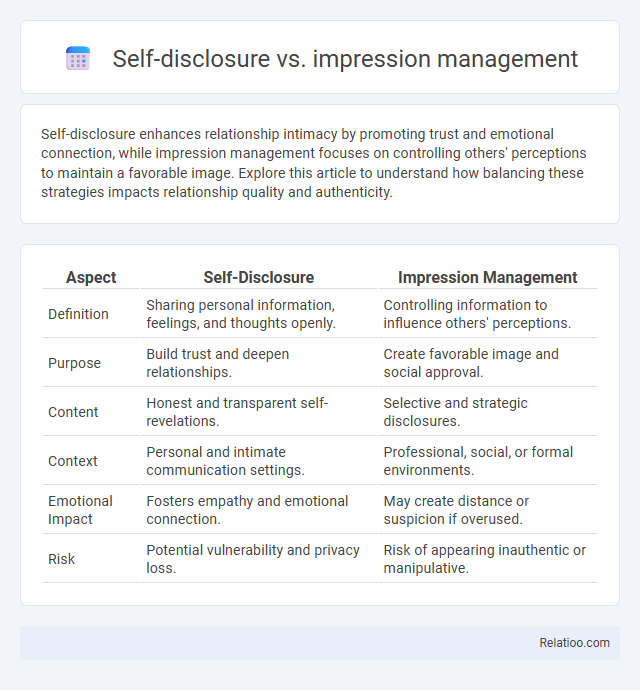Self-disclosure enhances relationship intimacy by promoting trust and emotional connection, while impression management focuses on controlling others' perceptions to maintain a favorable image. Explore this article to understand how balancing these strategies impacts relationship quality and authenticity.
Table of Comparison
| Aspect | Self-Disclosure | Impression Management |
|---|---|---|
| Definition | Sharing personal information, feelings, and thoughts openly. | Controlling information to influence others' perceptions. |
| Purpose | Build trust and deepen relationships. | Create favorable image and social approval. |
| Content | Honest and transparent self-revelations. | Selective and strategic disclosures. |
| Context | Personal and intimate communication settings. | Professional, social, or formal environments. |
| Emotional Impact | Fosters empathy and emotional connection. | May create distance or suspicion if overused. |
| Risk | Potential vulnerability and privacy loss. | Risk of appearing inauthentic or manipulative. |
Understanding Self-Disclosure and Impression Management
Understanding self-disclosure involves recognizing the deliberate sharing of personal information to build trust and intimacy in relationships, while impression management focuses on controlling how others perceive us by selectively revealing or concealing information. Both processes play critical roles in social interactions, as self-disclosure fosters genuine connections, whereas impression management aims to maintain a desired image or social identity. Effectively balancing these elements enhances communication authenticity and relational satisfaction.
Key Differences Between Self-Disclosure and Impression Management
Self-disclosure involves sharing personal information to build trust and authenticity, whereas impression management aims to control others' perceptions by selectively revealing or concealing information. Key differences include the intent behind communication, with self-disclosure fostering genuine connection and impression management prioritizing image crafting. While self-disclosure encourages openness, impression management often employs strategic communication to influence social outcomes.
The Role of Honesty in Self-Disclosure
Honesty is crucial in self-disclosure, as it fosters trust and authentic connections, distinguishing it from impression management, which often involves strategic or selective sharing to shape others' perceptions. While self-disclosure involves revealing true thoughts and feelings, impression management may sacrifice honesty to maintain a desired image. Your genuine openness enhances relationships by promoting understanding, whereas dishonest disclosure can undermine credibility and social bonds.
Strategies Used in Impression Management
Impression management employs strategies such as self-presentation, selective self-disclosure, and behavioral conformity to influence others' perceptions, differing from straightforward self-disclosure, which involves sharing personal information openly. Unlike self-disclosure that fosters intimacy by revealing authentic thoughts and feelings, impression management strategically curates information to maintain a desired social image. Techniques include ingratiation, self-promotion, exemplification, and supplication, all aimed at controlling how one is perceived in various social contexts.
Psychological Motivations Behind Each Approach
Self-disclosure is driven by the psychological motivation to build intimacy and trust by sharing personal information, fostering deeper connections and emotional authenticity. Impression management focuses on controlling others' perceptions to achieve social approval and enhance one's image, motivated by desires for acceptance, status, or influence. Balancing these strategies involves navigating the tension between genuine self-expression and the strategic presentation of oneself based on underlying needs for belonging and self-esteem.
Effects on Interpersonal Relationships
Self-disclosure fosters trust and intimacy by promoting openness and vulnerability, which strengthens interpersonal relationships. Impression management, while useful for creating favorable perceptions, can hinder genuine connections if perceived as manipulative or insincere. Balancing authentic self-disclosure with strategic impression management enhances relationship quality by maintaining both honesty and social harmony.
Self-Disclosure and Trust Building
Self-disclosure involves sharing personal information to build trust and deepen relationships, fostering authenticity and emotional connection. Impression management, by contrast, focuses on controlling the image you present to others, often prioritizing social approval over genuine openness. Your willingness to engage in honest self-disclosure directly enhances trust building, creating a foundation for meaningful and lasting interpersonal connections.
Impression Management in Professional Settings
Impression management in professional settings involves strategically controlling the information and behaviors shared with colleagues to project a competent and trustworthy image. Unlike self-disclosure, which emphasizes sharing personal thoughts and feelings, impression management prioritizes tailoring communication to align with workplace norms and expectations. Effective impression management can enhance professional relationships and career advancement by fostering credibility and positive perceptions.
Risks and Benefits of Self-Disclosure
Self-disclosure involves sharing personal information, which can build trust and deepen relationships but also carries risks such as privacy loss and vulnerability to judgment. Impression management focuses on controlling how others perceive you, often limiting genuine expression to avoid negative evaluation. Your decision to self-disclose must balance the benefits of authenticity and connection against potential risks like misuse of information or damage to your reputation.
Balancing Authenticity and Social Image
Balancing authenticity and social image requires navigating the delicate interplay between self-disclosure and impression management. You reveal personal information through self-disclosure to build trust and intimacy, while impression management involves controlling how others perceive you to maintain a positive social image. Mastering both strategies helps achieve genuine connections without compromising your desired public persona.

Infographic: Self-disclosure vs Impression management
 relatioo.com
relatioo.com